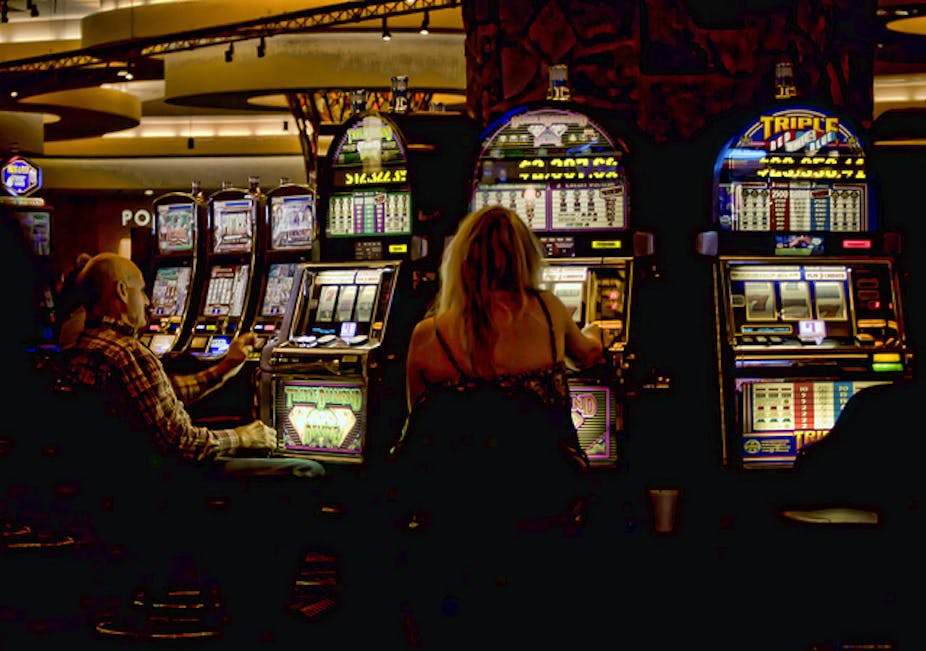Most people are aware of the harms of problem gambling. Playing pokie machines, placing bets and visiting casinos can be a very expensive form of entertainment. And when gamblers lose more than they can afford, the consequences can be disastrous for the person playing and their family.
But gambling products are only harmful when people consume too much of them. Gambling is like alcohol: occasional use is generally safe. So, just like the two-drink maximum for alcohol, establishing guidelines for “responsible” gambling could reduce the risk of overuse.
Use, do not abuse… neither abstinence nor excess ever renders man happy –– Voltaire
Defining problem gambling
Is problem gambling a mental illness? Unfortunately there is no simple answer. “Disordered gambling” is the only purely behavioural form of addiction recognised in the fifth edition of the Diagnostics and Statistical Manual of the American Psychiatric Association, known as the psychiatrists’ bible.
Gambling disorders are associated with very serious harms, making them a legitimate focus of public concern. People with gambling disorders are more likely to die by suicide than people suffering from other substance-related addictions, and many otherwise law-abiding people end up in jail for crimes committed to support their gambling.
Nevertheless, some experts are hesitant to view gambling as a medical condition because it suggests that medication is the most appropriate treatment. It also ignores the role that the gambling industry, government regulation and personal responsibly play in either promoting or protecting people from gambling harms.
Australian researchers have devised a pragmatic approach to define gambling in terms of people’s difficulties in limiting money and/or time spent on gambling which leads to adverse consequences for the gambler, others, or for the community.
As suggested by this definition, problem gambling can be neatly defined as consuming “too much” of gambling products. In fact, many people with gambling problems tend to consume too much of many other products that cause some harms: unhealthy foods, alcohol, tobacco and illicit substances. This over-consumption can end up destroying a person’s physical health and mental well-being.
The proliferation of gambling products offer abundant opportunities for consumption. Likewise, developed countries have become adept at fulfilling our nearly insatiable desires for food, consumer goods, chemical substances and stimulating activities.
The evolutionary drive to gamble
Gambling is an activity that fulfils a deep biological need to acquire resources for our betterment. In our evolutionary past, this overwhelming desire was a psychological mechanism conferring fitness. Those people with the “need to acquire” efficiently accumulated resources to survive and procreate, and thereby ultimately became our ancestors.
Gambling is a potent abstract means to satisfy this biological urge for acquisition, and gambling products are carefully constructed through much iteration of successful and unsuccessful games of chance to maximally appeal to consumers’ interests. Although gambling products bear little functional resemblance to tasks and rewards in our evolutionary past, they have been enhanced and refined to create an outsized appeal to our motives.
Within this framework, supernormal stimuli are exaggerated versions of original stimuli that evolved in our past as adaptive responses. Supernormal stimuli can create an over-reaction in animals; for example, where a bird is attracted to care for an abnormally large egg that is outside of the normal range for the species.
Gambling, likewise, is a supernormal stimulus for acquisition of a universal resource, money, that is symbolically – and in some cases actually – a resource that conveys fitness. This can cause people to invest too much of their time or money in an activity that only has real value as entertainment.
How much gambling is ‘too much’?
It is possible to set safe levels of gambling, where people can enjoy the recreation of gambling without causing themselves or other harms through overspending. North American addiction researcher Shawn Currie, for instance, found that Canadians who spent less than 1% of their gross income on gambling, gambled no more than two to three times per month, and spent less than CAN$1,000 a year were unlikely to experience harm from gambling.
The Canadians have given us some indication of how much gambling is “too much”, but ultimately Australian research will be needed to provide simple guidelines for our country and our gamblers.
Unlike tobacco smoking, which can be harmful at any level of use, modest levels of gambling can be both entertaining and non-harmful. In fact, a recent New South Wales prevalence survey found that many regular gamblers nominated that their lives had been made “more enjoyable” as a result of their gambling.
Ending the blame game
It is easy to blame the gambling industry, lax regulation or gamblers themselves for the harm that gambling can cause. But rather than getting caught in a cycle of shifting responsibility, it’s much more productive to see that everyone can play an important role in limiting gambling consumption under “safe” thresholds.
The gambling industry can promote responsible playing behaviour, and make it clear to consumers how much gambling is “too much”.
Government can implement soft controls, such as pre-commitment technologies and requirements to notify players about how much time and money they have spent gambling. And public health agencies can promote other healthy alternatives to gambling to mollify consumptive urges.
Finally, gamblers can take personal responsibility for keeping their gambling within the known safe limits.
When everybody takes responsibility for preventing gambling problems, everybody wins.

